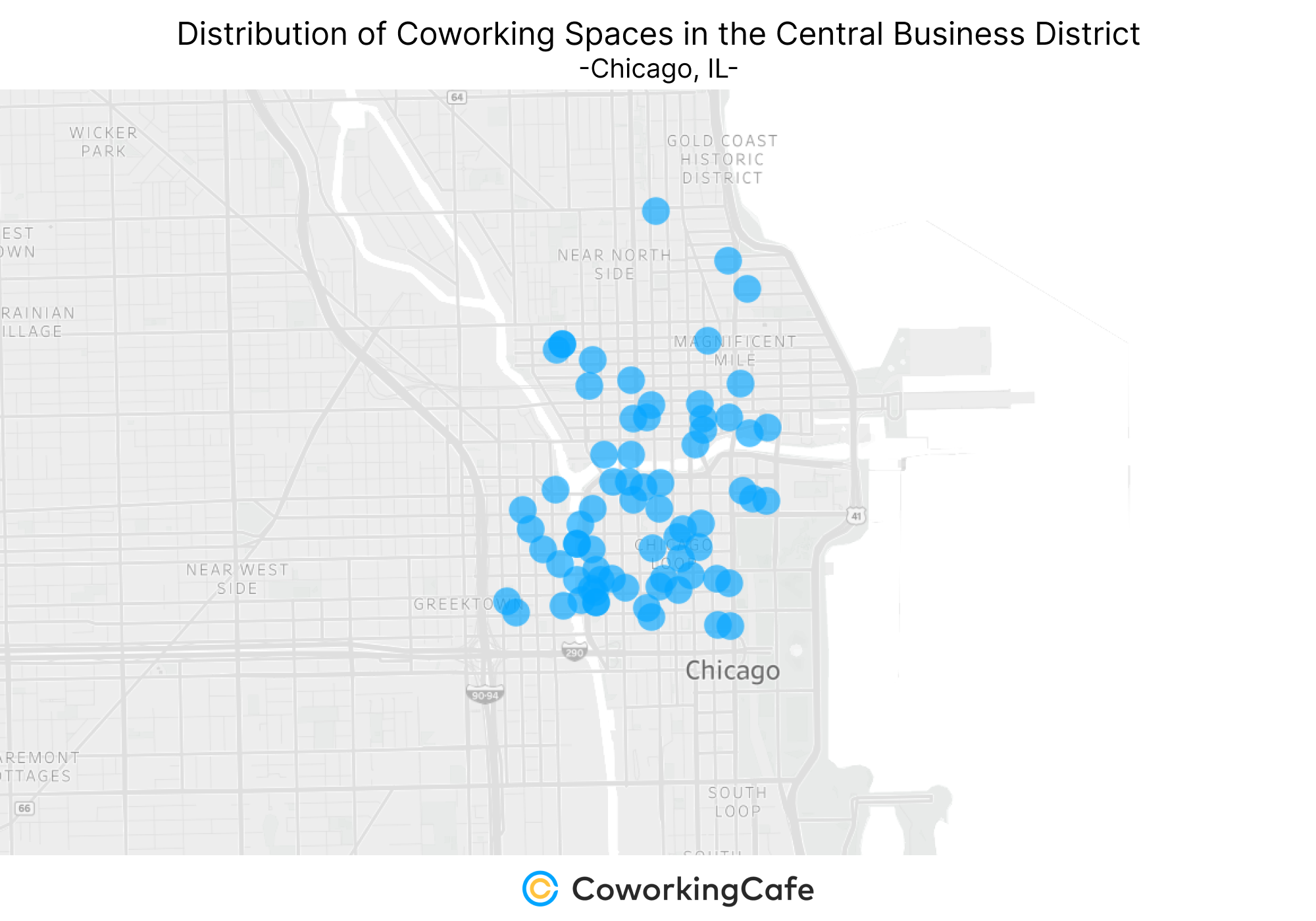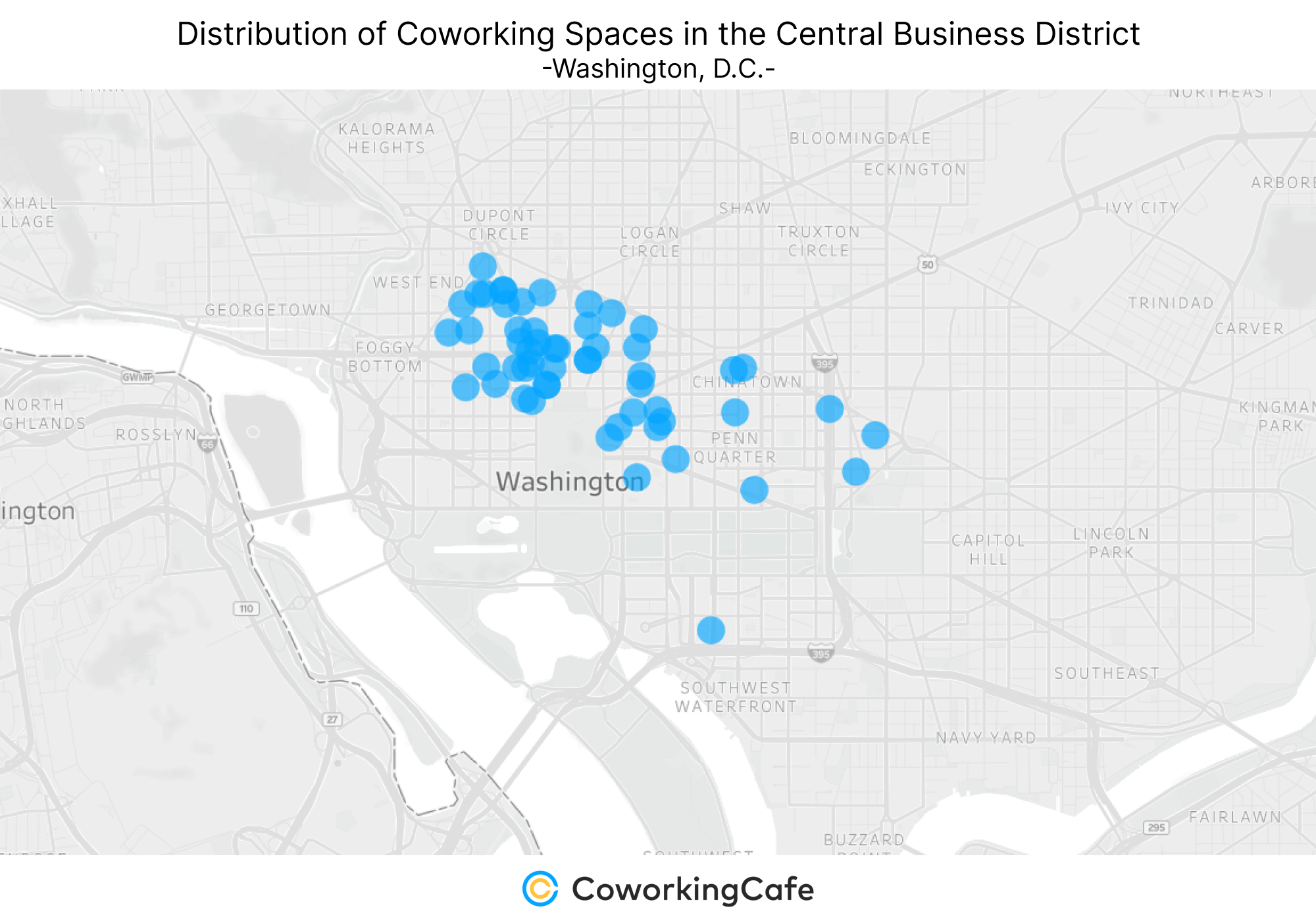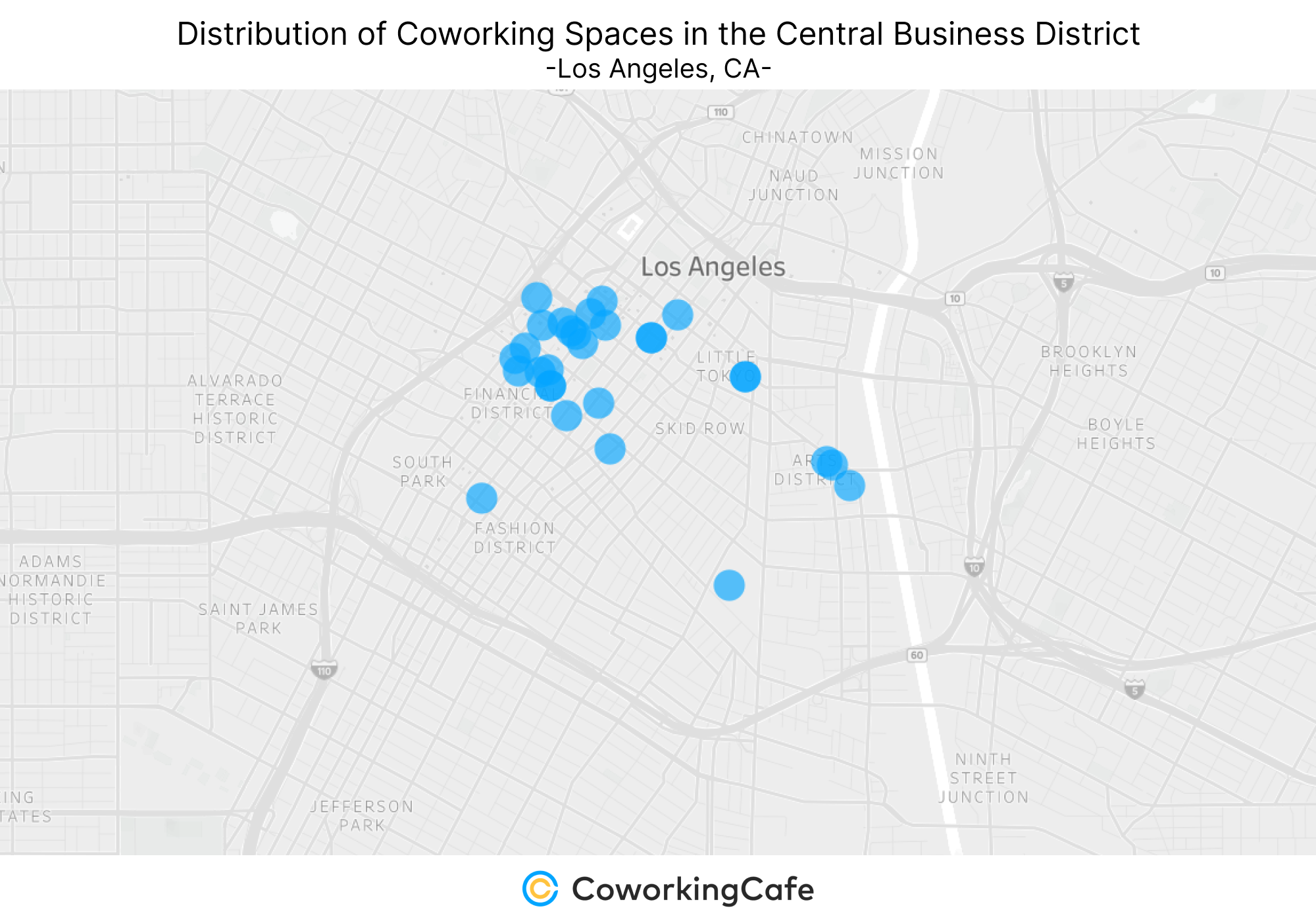Key Takeaways:
- New York City, NY, had the most coworking spaces in CBD locations with a total of 180 shared office spaces split between Midtown and the Financial District.
- Half of all U.S. downtown coworking spaces were concentrated in just five major cities.
- Oakland, CA; Washington, D.C.; Philadelphia, PA; and Chicago, IL had more than two-thirds of their coworking spaces concentrated in their business districts.
- Denver, CO and three Texas cities — Houston, Austin and Dallas — made the top 20, despite having more than 80% of their flex workspaces outside of their CBDs.
- Although Atlanta, GA was the third-largest coworking market by location count, only 6% of these were downtown.
As remote work continues to gain in popularity, coworking spaces have become a go-to solution not only for gig-economy workers, but also for large enterprise clients to set up shop. And, while coworking spaces fit well into various types of urban and suburban settings, they’re a particularly good alternative to traditional office space in central business districts (CBDs). Furthermore, because these prime locations and limited spaces cause many ambitious startups and small- and medium-sized businesses to be priced out of traditional office buildings, coworking spaces are especially sought-after in the commercial and economic hubs of our largest cities.
With this in mind, this study ranked the top 20 cities in the U.S. with the highest concentrations of flexible office spaces in their core business sectors. Additionally, it also offers a closer look at the distribution of flexible workspaces within some of the nation’s most significant coworking powerhouses.
Top 20 U.S. Business Districts Boast 10+ Coworking Spaces
While most large cities still have relatively few flexible office spaces in their business districts, some CBDs have emerged as early adopters. Of course, the top 20 cities by downtown coworking options are spread all throughout the country, although there is a higher concentration in the Northeast and West Coast regions. And, the top five cities are all major office markets with some of the largest populations. As such, there are various factors contributing to their high rankings.
To better visualize the distribution of the most significant business districts for coworking across the U.S., we created a map showcasing the top 20 cities by the number of shared offices in their CBDs.
Notably, the vast majority of the significant CBDs for coworking are located on the East Coast, with New York, NY; Boston, MA; Philadelphia, PA; Pittsburgh, PA and Washington, D.C. anchoring the Mid-Atlantic megalopolis, supported by three Florida hubs: Miami, Orlando and Fort Lauderdale. In fact, the business districts of these eight cities alone counted more than 300 coworking spaces in total.
Across the country, the West Coast was also well-represented in the top 20 with the business districts of four California cities — Los Angeles, San Diego, San Francisco and Oakland — plus Seattle, WA totaling 83 downtown flex office locations. Texas also fared well in the ranking with Houston, Austin and Dallas in top positions and contributing 42 coworking spaces in their CBDs. Meanwhile, Chicago, IL was the only city representing the Midwest. Even so, the 71 coworking spaces in the Windy City’s business district earned it second place in our ranking.
Half of All U.S. CBD Coworking Spaces Concentrated in 5 Cities
With such a high concentration of businesses, startups, and entrepreneurs, it comes as no surprise that New York City, NY, topped the list with 180 coworking spaces concentrated in Midtown Manhattan and the Financial District. All told, these accounted for 53% of all flexible offices within the five boroughs.
Despite brimming with office-using clientele from essentially all industries, Manhattan’s business districts are notorious for the limited office space where all but the most well-established firms can afford traditional, long-term office leases. At the same time, a myriad of startups and other companies with limited budgets also want to be close to the heart of business. And nowadays, even the large enterprises that are well-anchored in these neighborhoods are now leaning toward flexible solutions, which is the ideal environment for coworking if there ever was one. Clearly, it’s no mistake that WeWork — a brand synonymous with the coworking concept for the general public — first launched its operations in the Big Apple and still calls Manhattan home.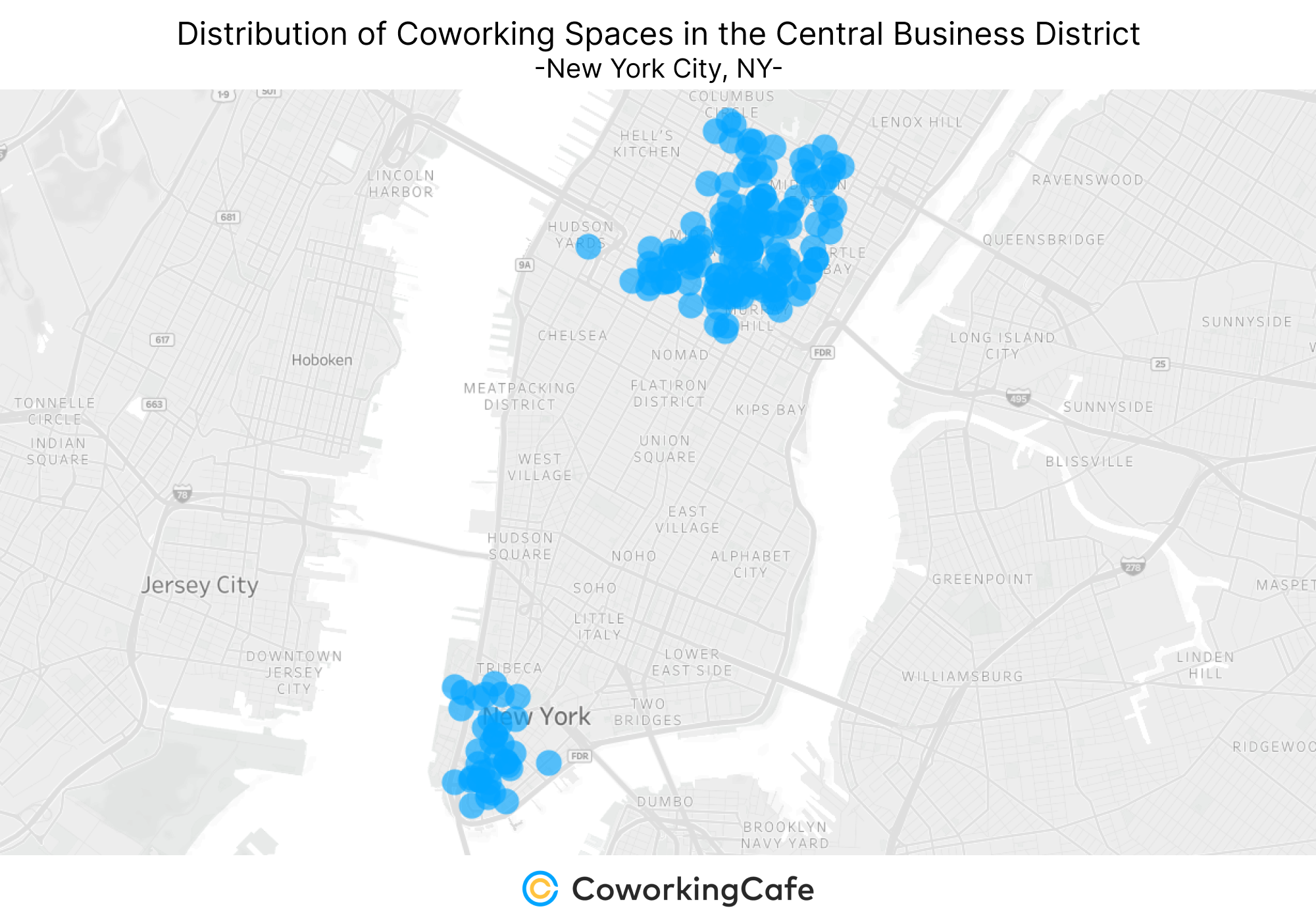 Meanwhile, the second-place city, Chicago, IL boasted 71 flexible office locations within The Loop and River North. In other words, two out of three Chicago coworking spaces were concentrated in the CBD. As the third-largest city in the U.S., Chicago is a major business hub with a thriving tech industry that’s home to many businesses, startups and freelancers looking for flexible office space. Moreover, the strong entrepreneurial spirit in the Windy City was also apparent in the sheer number of coworking spaces in its relatively restricted business district.
Meanwhile, the second-place city, Chicago, IL boasted 71 flexible office locations within The Loop and River North. In other words, two out of three Chicago coworking spaces were concentrated in the CBD. As the third-largest city in the U.S., Chicago is a major business hub with a thriving tech industry that’s home to many businesses, startups and freelancers looking for flexible office space. Moreover, the strong entrepreneurial spirit in the Windy City was also apparent in the sheer number of coworking spaces in its relatively restricted business district.
Next, the nation’s capital followed with 55 coworking spaces. Here, a whopping 74% of the Washington, D.C. flex workspace inventory was located in the CBD — mostly downtown, but also extending into Penn Quarter, as well as a handful in the East End. Of course, the high concentration of government agencies, non-governmental organizations, and advocacy groups concentrated in the central areas of the nation’s capital are all viable clients for coworking, which explains the high density in the CBD. Otherwise, the remaining shared office spaces were spread out in a radial pattern along the main access routes, thereby allowing coworkers from the surrounding suburbs to save precious time on commuting.
On the opposite coast, Los Angeles, CA actually had a larger coworking space inventory than Washington, D.C. (94 locations compared to D.C.’s total of 74). However, LA only recorded 24 flex offices in its central business district, most of which were in the Financial District and Bunker Hill. A handful of shared office spaces were also scattered across the Arts District, the Fashion District, South Park and Little Tokyo — underscoring once again that downtown Los Angeles is recovering and ready to adopt the latest trends in office use amid a wave of ongoing construction and an influx of new businesses.
Philadelphia, PA rounded out the top five with 28 downtown coworking spaces, which made for an impressive 68% of the local inventory. Because the CBD is geographically bound by two rivers and fenced by residential neighborhoods, it makes sense that most of the flex office spaces would be in this area, too. However, with only 13 coworking spaces outside the central area, most of northern and northeastern Philadelphia remained largely underserved.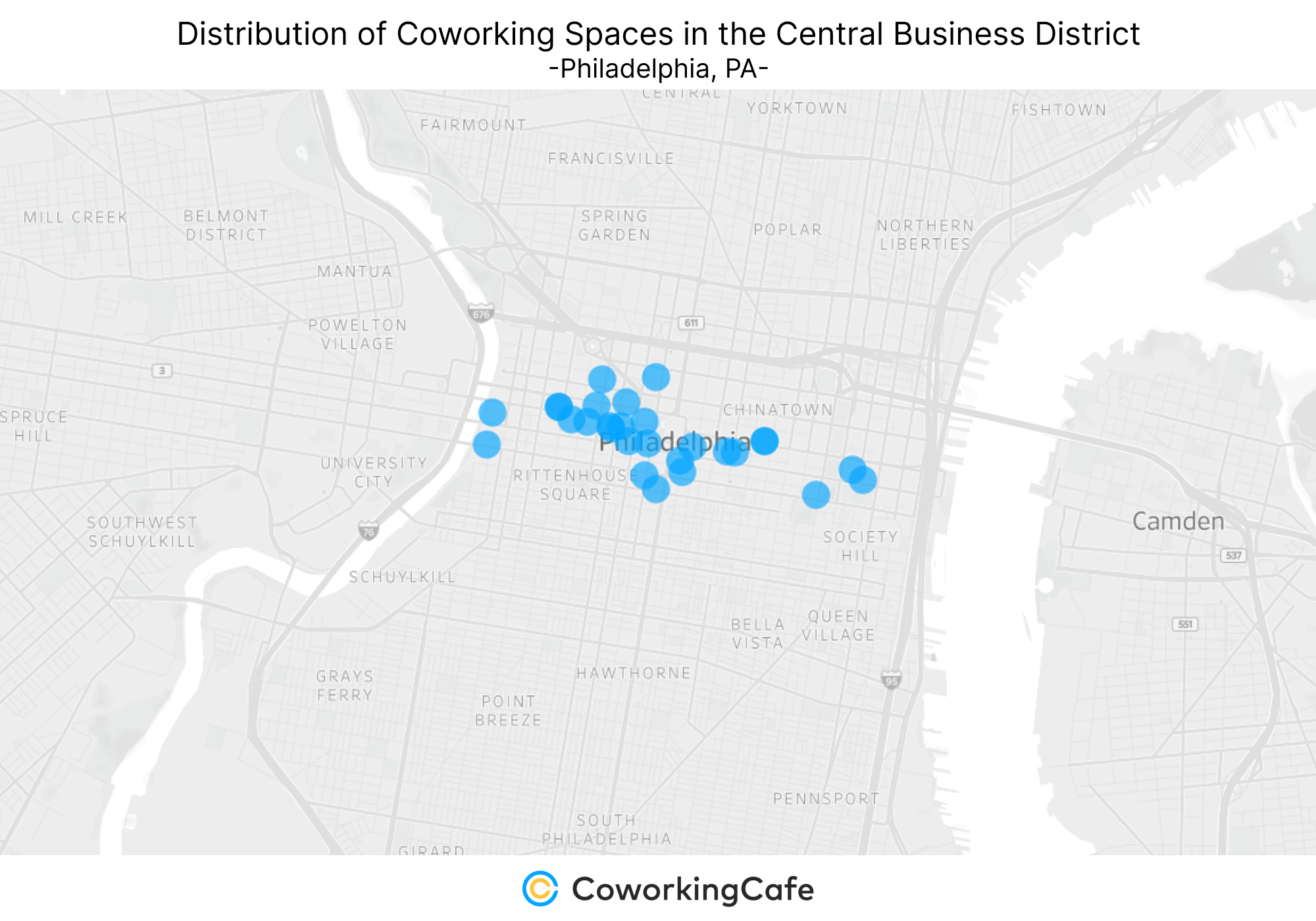
Coworking Sprawl? Cities with Lowest Appetite for Flex Workspaces in CBDs
Although it seems natural for office spaces of all kinds to gravitate toward central, well-connected areas, coworking spaces often come to see the light of day along a radically different thought process. After all, coworking is all about flexibility. So, it’s almost as if steering off the beaten path every now and then is something that’s encoded in the DNA of the flex workspace segment. Consequently, in some cities, this induced some unique development patterns.
In this case, Atlanta, GA was one of the most striking examples: Although the Big Peach was the third-largest coworking market with an impressive 109 locations, only 6% of these were in the CBD — mostly on the Peachtree Center blocks and in downtown. But, further north (from Tech Square through Midtown Atlanta), there’s a significant concentration of coworking spaces, and the traditional office hubs in the Perimeter Center, Cumberland and Buckhead areas have attracted significantly more coworking operators than the suburbs.
Interestingly, Las Vegas, NV; Charlotte, NC and Houston, TX are rarely seen as a trio, yet here they are in a tie for second place on this list: All three had just 10% of their coworking inventories located in their business districts. Namely, Las Vegas was unique among large cities because of how coworking spaces in its urban and suburban neighborhoods were spread out relatively evenly with virtually no well-defined hotspots throughout the city. Conversely, coworking spaces in Charlotte were more consolidated around the downtown area, although only four of the Queen City’s 39 coworking spaces were in the Center City neighborhood that’s defined as the CBD. Meanwhile, Houston’s case was noteworthy because, despite accounting for just 10% of the local inventory, the 15 coworking offices in Space City’s downtown area earned it 8th place in the overall ranking.
Finally, Indianapolis, IN completed the podium for the least downtown-focused coworking markets with a mere 15% of its inventory huddled in the Mile Square area. Granted, there was a significant cluster of coworking spaces in the wider downtown area, but most of the city’s flexible workspace inventory was scattered along the beltway, particularly near the lively Keystone at the Crossing and College Park areas.
Methodology
- The data used for this study reflects the available coworking space inventory as of March 1, 2023, and only includes properties that had been completed and open to the public.
- The analysis only included cities with three or more coworking spaces in their central business districts.
- The New York City data point included all five boroughs (The Bronx, Brooklyn, Manhattan, Queens and Staten Island).
- Definitions for the CBDs were used as provided by Yardi Matrix Real Estate Intelligence Source, and area delimitations were traced by local real estate professionals.


